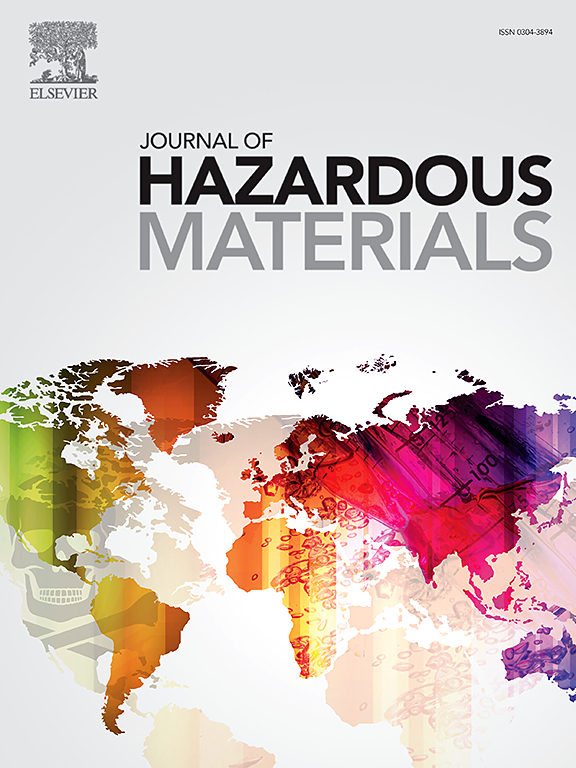2,2',4,4'-四溴二苯醚和铜通过调控 NAC23-Tre6P-SnRK1a 信号通路干扰水稻蔗糖的源-汇分配
IF 11.3
1区 环境科学与生态学
Q1 ENGINEERING, ENVIRONMENTAL
引用次数: 0
摘要
2,2',4,4'-四溴联苯醚(BDE-47)和铜(Cu)在农田中的共存对作物生长和粮食生产具有重要影响。本研究探讨了它们对水稻作物的单独和联合作用,并结合体内、体外和计算机研究阐明了潜在的机制。在与环境相关的暴露浓度下,BDE-47和Cu均抑制茎部生物量,而根部生物量表现出不同的特征:BDE-47抑制茎部生物量,而Cu促进茎部生物量。这一现象归因于蔗糖在源(茎)和汇(根)之间的转运差异。此外,代谢、转录和翻译分析表明,这一过程是由NAC23-Tre6P-SnRK1a信号通路调节的,果糖-1,6-二磷酸醛醇酶(FBA)功能障碍和细胞内蔗糖水平的改变是关键的负面因素。这两种污染物都与FBA结合,破坏葡萄糖信号传递并上调SnRK1a的表达。此外,BDE-47抑制蔗糖水平,从而降低NAC23活性并抑制蔗糖运输。相反,Cu显著提高蔗糖水平,减轻SnRK1a对NAC23的不利影响,增强蔗糖运输。有趣的是,Cu与BDE-47共存可协同抑制蔗糖转运,进一步减少根生物量,降低BDE-47对水稻作物的毒性阈值。该研究为BDE-47和Cu对水稻生长和产量影响的信号调控机制提供了新的见解,有助于更准确地评估它们的植物毒性,并为农田的科学监管框架提供信息。本文章由计算机程序翻译,如有差异,请以英文原文为准。

2,2′,4,4′-Tetrabromodiphenyl ether and copper disturbed the source-to-sink allocation of sucrose in rice through regulating the NAC23-Tre6P-SnRK1a signaling pathway
The co-occurrence of 2,2′,4,4′-tetrabromodiphenyl ether (BDE-47) and copper (Cu) in agricultural fields pose significant implications for crop growth and grain production. This study explored their individual and combined effects on rice crops and elucidated the underlying mechanisms combining in vivo, in vitro, and in silico investigations. Both BDE-47 and Cu inhibited shoot biomass, whereas root biomass exhibited distinct profiles: BDE-47 inhibited it, while Cu promoted it, at environmentally relevant exposure concentrations. This phenomenon was attributed to differences in sucrose transport between the source (shoot) and sink (root). Furthermore, metabolic, transcriptional, and translational analyses unveiled that this process was modulated by the NAC23-Tre6P-SnRK1a signaling pathway, with the dysfunction of fructose-1,6-diphosphate aldolase (FBA) and alterations in intracellular sucrose level serving as the crucial negative factors. Both contaminants bound to FBA, disrupting glucose signal transmission and upregulating SnRK1a expression. Additionally, BDE-47 suppressed sucrose levels, thereby reducing NAC23 activity and inhibiting sucrose transport. Conversely, Cu significantly elevated sucrose levels, mitigating the adverse effects of SnRK1a on NAC23 and enhancing sucrose transport. Interestingly, the coexistence of Cu with BDE-47 synergistically inhibited sucrose transport, further reducing root biomass and lowering the toxicity threshold of BDE-47 on rice crops. This study offered novel insights into the signaling regulatory mechanisms governing the differential impacts of BDE-47 and Cu on rice growth and yield production, facilitating more accurate assessments of their phytotoxicity and informing scientific regulatory frameworks for croplands.
求助全文
通过发布文献求助,成功后即可免费获取论文全文。
去求助
来源期刊

Journal of Hazardous Materials
工程技术-工程:环境
CiteScore
25.40
自引率
5.90%
发文量
3059
审稿时长
58 days
期刊介绍:
The Journal of Hazardous Materials serves as a global platform for promoting cutting-edge research in the field of Environmental Science and Engineering. Our publication features a wide range of articles, including full-length research papers, review articles, and perspectives, with the aim of enhancing our understanding of the dangers and risks associated with various materials concerning public health and the environment. It is important to note that the term "environmental contaminants" refers specifically to substances that pose hazardous effects through contamination, while excluding those that do not have such impacts on the environment or human health. Moreover, we emphasize the distinction between wastes and hazardous materials in order to provide further clarity on the scope of the journal. We have a keen interest in exploring specific compounds and microbial agents that have adverse effects on the environment.
 求助内容:
求助内容: 应助结果提醒方式:
应助结果提醒方式:


